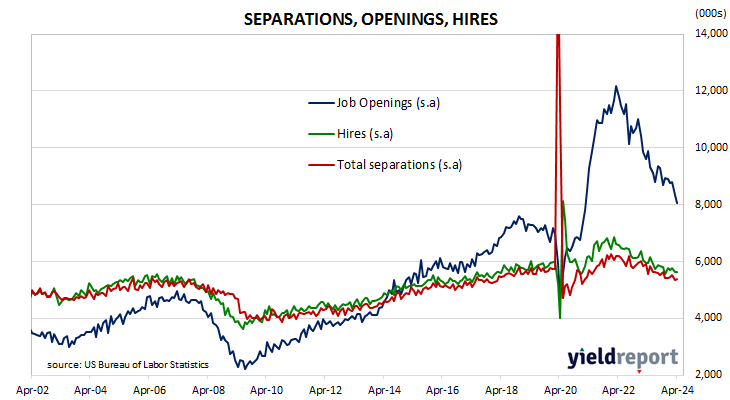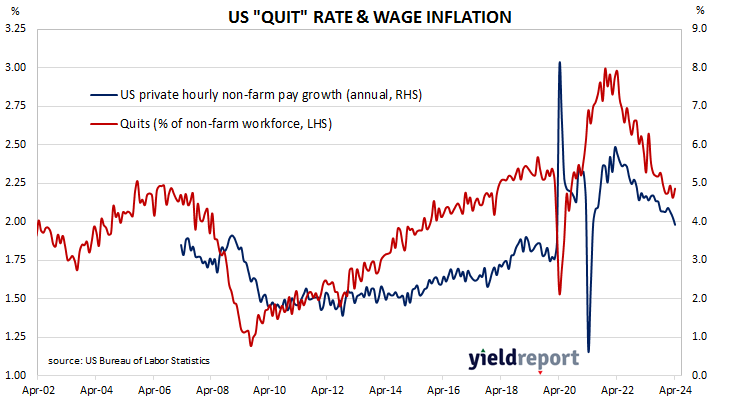Summary: US quit rate steady at 2.2% in April; Westpac: more evidence of labour demand, supply coming into balance; US Treasury yields fall; expectations of Fed rate cuts firm; ANZ: job openings to available workers ratio falls, at lowest level since July 2021; more quits, separations, fewer openings.
The number of US employees who quit their jobs as a percentage of total employment increased slowly but steadily after the GFC. It peaked in March 2019 and then tracked sideways until virus containment measures were introduced in March 2020. The quit rate then plummeted as alternative employment opportunities rapidly dried up. Following the easing of US pandemic restrictions, it proceeded to recover back to its pre-pandemic rate in the third quarter of 2020 and trended higher through 2021 before easing through 2022 and 2023.
Figures released as part of the latest Job Openings and Labor Turnover Survey (JOLTS) report show the quit rate remained steady in April after revisions. 2.2% of the non-farm workforce left their jobs voluntarily, unchanged from March. Quits in the month increased by 98,000 while an additional 175,000 people were employed in non-farm sectors.
“The hiring, separation and quit rates have already converged to pre-pandemic levels,” said Westpac economist Jameson Coombs. “This report is yet more evidence of labour demand and supply coming into balance.”
US Treasury yields fell across the curve on the day. By the close of business, the 2-year Treasury bond yield had lost 4bps to 4.77% while 10-year and 30-year yields both finished 6bps lower at 4.33% and 4.48% respectively.
In terms of US Fed policy, expectations of a lower federal funds rate in the next 12 months firmed, with three 25bp cuts now factored in. At the close of business, contracts implied the effective federal funds rate would average 5.33% in June, in line with the current spot rate, 5.325% in July and 5.23% in September. May 2025 contracts implied 4.525%, 79bps less than the current rate.
“Job openings are now at their lowest since early 2021,” noted ANZ economist Kishti Sen. “The ratio of job openings to available workers fell to 1.24 from 1.32 and is at its lowest level since July 2021, when the data were affected by the pandemic.”
The rise in total quits was led by 67,000 more resignations in the “Other services” sector while the “Professional and business services” sector experienced the largest decrease, falling by 131,000. Overall, the total number of quits for the month increased from March’s revised figure of 3.409 million to 3.507 million.
Total vacancies at the end of April dropped by 296,000, or 3.5%, from March’s revised figure of 8.355 million to 8.059 million. The fall was driven by 204,000 fewer open positions in the “Health care and social assistance” sector while the “Professional and business services” sector experienced the single largest increase, rising by 122,000. Overall, 13 out of 18 sectors experienced fewer job openings than in the previous month.
Total separations increased by 42,000, or 0.8%, from March’s revised figure of 5.330 million to 5.372 million. The rise was led by the “Health care and social assistance” sector where there were 66,000 more separations while the “Professional and business services” sector experienced 140,000 fewer separations. Separations increased in 10 of the 18 sectors.

The “quit” rate time series produced by the JOLTS report is a leading indicator of US hourly pay. As wages account for around 55% of a product’s or service’s price in the US, wage inflation and overall inflation rates tend to be closely related. Former Federal Reserve chief and current Treasury Secretary Janet Yellen was known to pay close attention to it.


